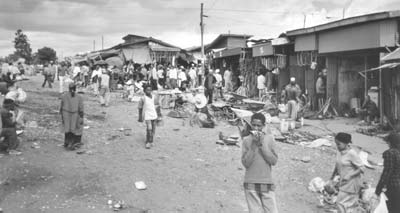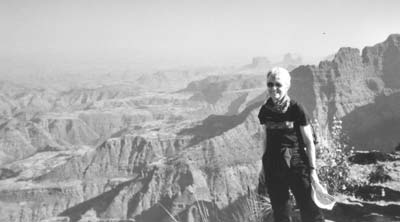Ethiopia with The Imaginative Traveller
Ethiopia and its people are poor. There is malnourishment and there is begging, though it’s not as bad as in India.
Addis Ababa, the capital, is described in the Lonely Planet guide as “massive and incoherent,” which seems apt. Modern, Western buildings are interspersed with shacks with corrugated-metal roofs. Major streets are paved, but the side streets often are dirt lanes.
Around Bole Road, where our tour stayed (at the Central Shoa Hotel — basic but with a good restaurant), there were villages seemingly transplanted from the countryside complete with goats, sheep, cows and their herdsmen.
Addis Ababa claims to have the largest open-air market in Africa: the Merkato. There are blocks of various shops packed together that seem to go on forever.
In Addis, I went to the Ethnological Museum on the campus of the university; I am not a big museum-goer, but the collections were interestingly displayed. The museum is housed in the palace of the former emperor Haile Selassie, and you can see the rooms he and his wife used as their bedrooms and baths.
I was on a 2-week “Ethiopia Explorer” tour of the “Historical Circuit” (Addis Ababa, Bahir Dar, Gondar, the Simien Mountains, Lalibela and Axum) with The Imaginative Traveller (Martlesham Heath, Suffolk, UK), booked through Adventure Center (1311 63rd St., Ste. 200, Emeryville, CA 94608; 800/227-8747, www.adventurecenter. com). The Imaginative Traveller is a budget British group, and I have used it and Adventure Center before.
The cost of the tour, in February ’07, was $1,391 plus $400 in local fees. I got a 15% discount for early booking. Round-trip air from San Francisco to Addis Ababa was $1,650 on Northwest and KLM. Breakfasts and most dinners were included in the tour price; I probably spent another $200 for additional meals and gifts. Our group comprised 15 travelers.
Accommodations on the tour were better than I expected. Several places we stayed were government hotels, and, except in Addis Ababa, I think we got the best available in each area. From what I saw in Lonely Planet, costs for the hotels we stayed in averaged about $50 per night.
Ethiopian food was, well, interesting. A variety of globs of this and that on a large injera (pancake); you tore a piece of it off and used it as a utensil to scoop up your selection.
I had porridge every morning, and there were bananas and, in Addis Ababa, a nice selection of fruit. There were choices of Italian food, since the Italians had been around Ethiopia for years, but how much spaghetti can you eat? By the time I boarded the KLM flight home, I was happy to see “regular” food.
From Bahir Dar to Gondar and Gondar to the Simien Mountains, we drove, bumpty-bump on rocky gravel roads. We flew from place to place for the rest of the trip. It isn’t practical, on roads in Ethiopia, to cover as much ground as we did in two weeks (and perhaps not in two months) without flying.
Lake Tana, near Bahir Dar, is quite large and lovely. Monasteries surround its shores and we took a boat to three of them.
From the old royal capital of Gondar, where my main memory is of the beautiful birds of various colors, we drove to the Simien Mountains to trek and camp. They reminded me of the Grand Canyon, only bigger — beautiful! On our walk, it was marvelous to watch some 50 or so gelada baboons gallivanting along the hillside, plus more gorgeously colored birds.
On the second day of our trek, we were accompanied by two scouts bearing Kalashnikov rifles; I wasn’t too sure about their skill as protectors, but, given what happened to a British group nearby, I guess their presence was needed. (On March 1, 2007, a group of five Western tourists, all with ties to the British Embassy in Addis Ababa, and eight Ethiopians were kidnapped in the Afar region. The suspects were Eritrean and the captives were held in Eritrea. The Western tourists were released unharmed after two weeks. The Ethiopians were not released until April 23.)
Lalibela is called “Africa’s Petra” with good reason. We saw half a dozen churches dug into the rock, with frescoes simple in design, bold in color and angular in style. We rode mules up the mountain to Ashetan Maryam, the “monastery in the sky.” At the very end, the path was so rocky that we climbed on while the mules stayed put.
Our last stop was Axum, supposedly the site of the Queen of Sheba’s capital in the 10th century B.C. The chapel of St. Mary of Zion is said to contain the Arc of the Covenant.
Two books I found good to read before a trip to Ethiopia are “Wilfred Thesiger, a Biography” by Michael Asher (Thesiger was a British explorer who lived many years in Ethiopia) and Phillip Marsden’s “Chains of Heaven,” which describes his trek from Lalibela to Axum.
JO RAWLINS GILBERT
Menlo Park, CA


